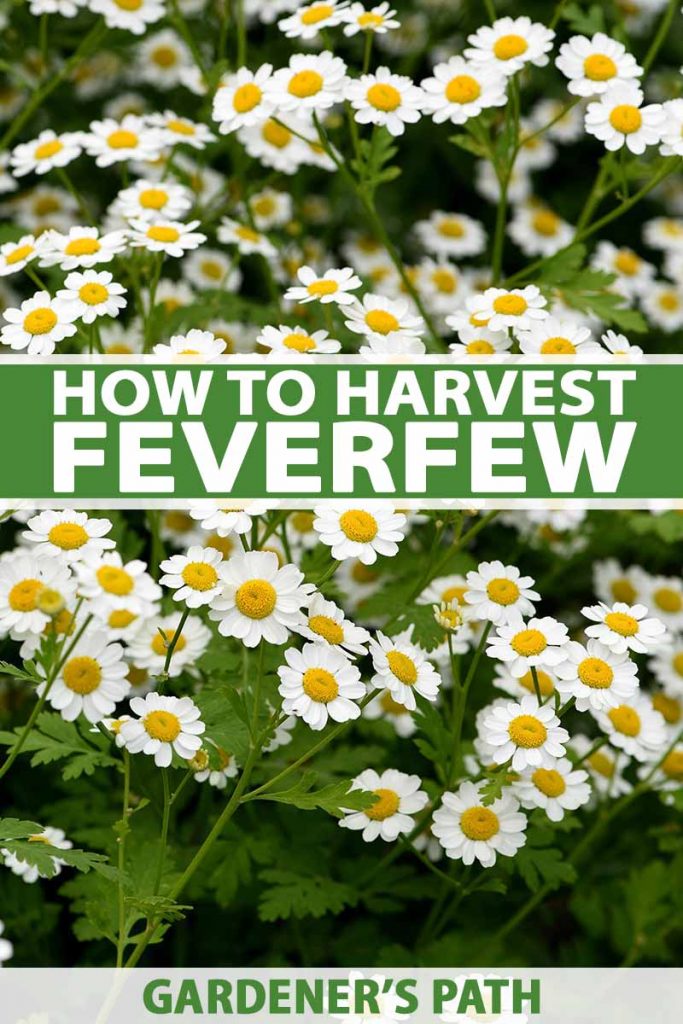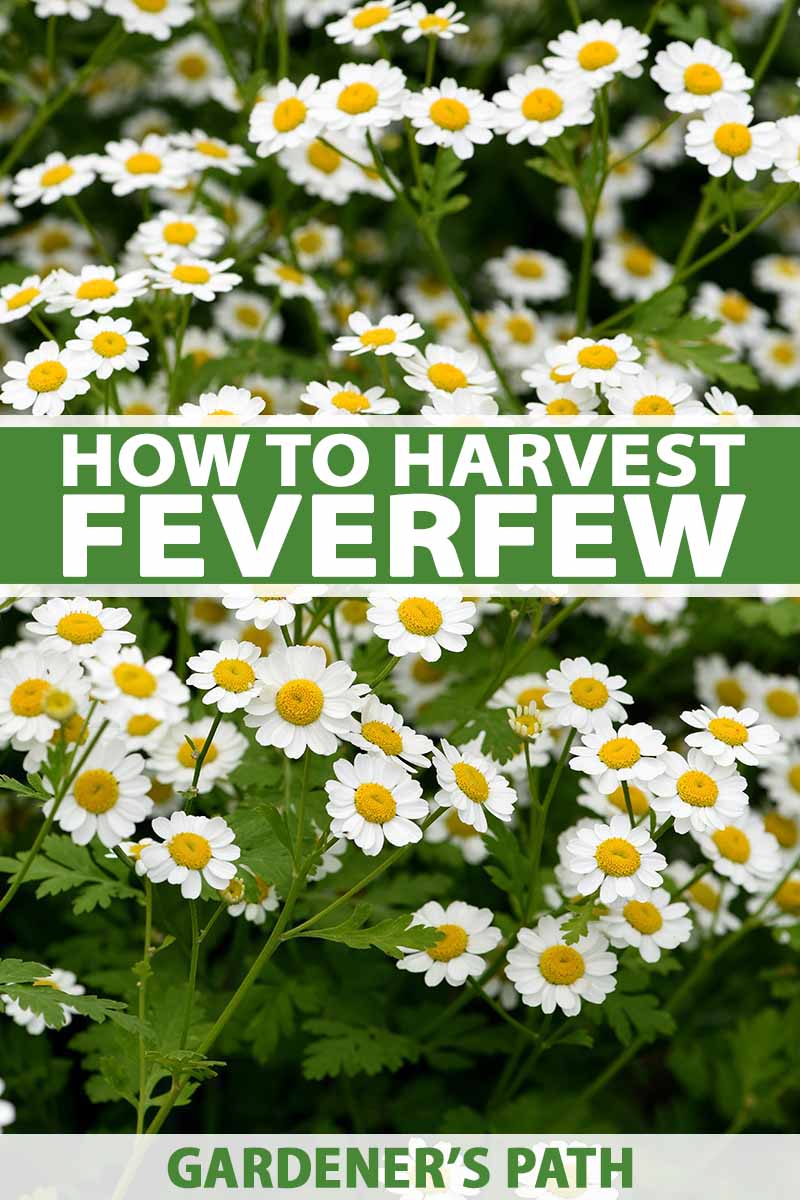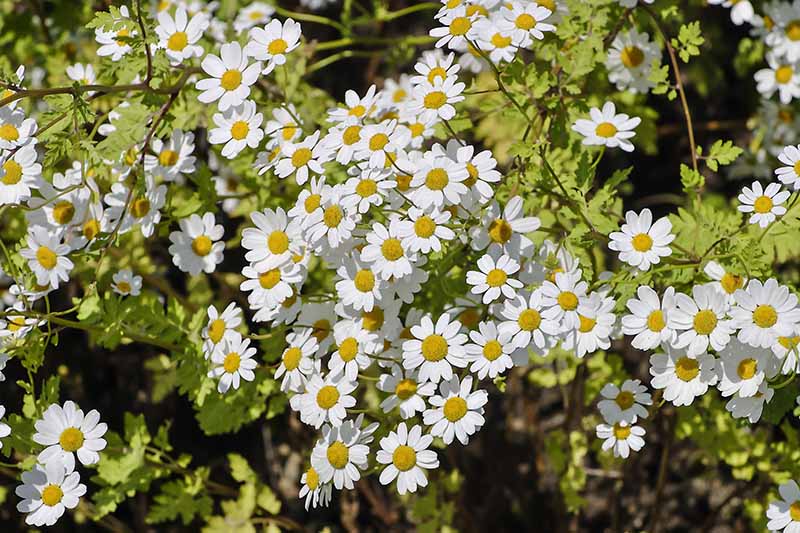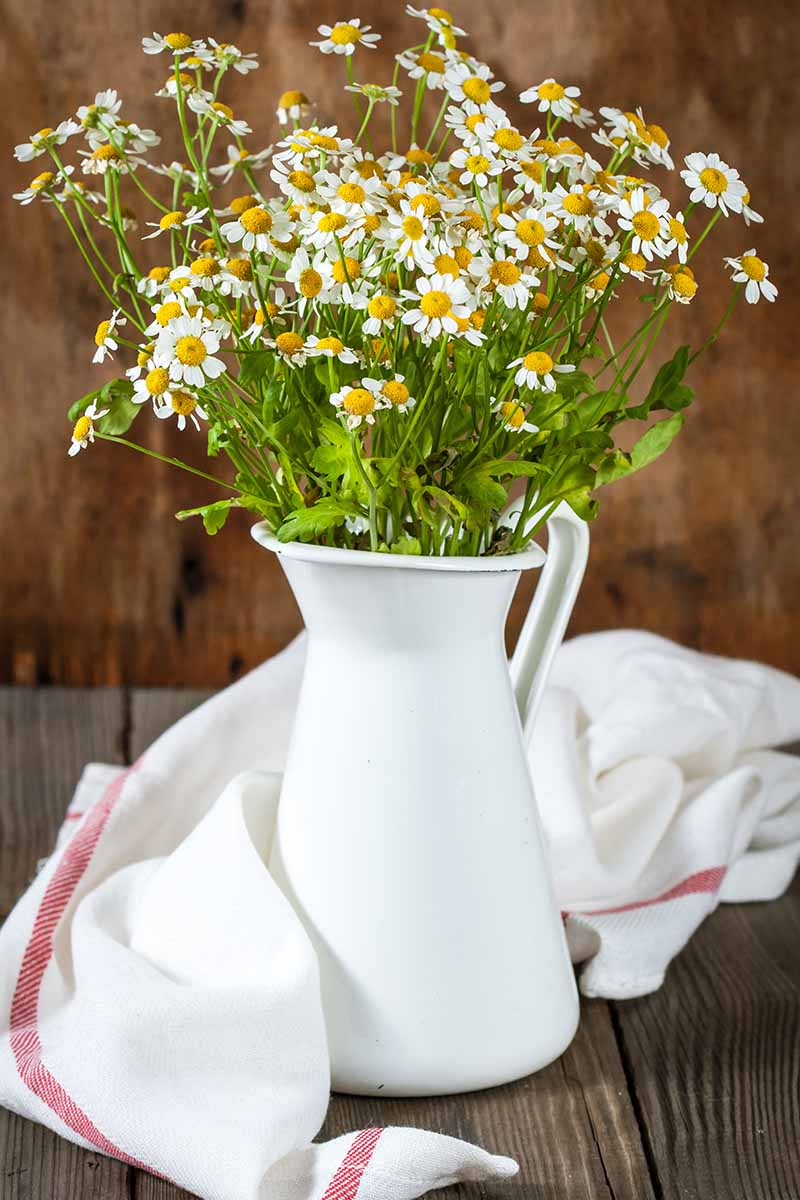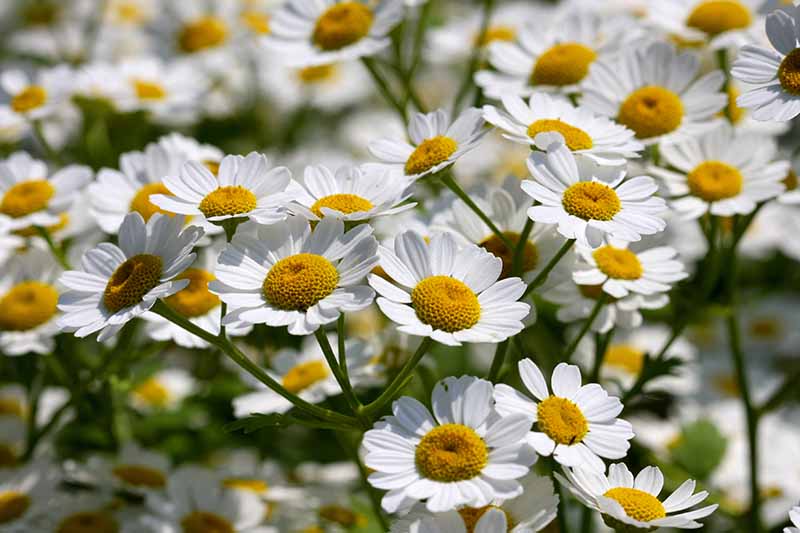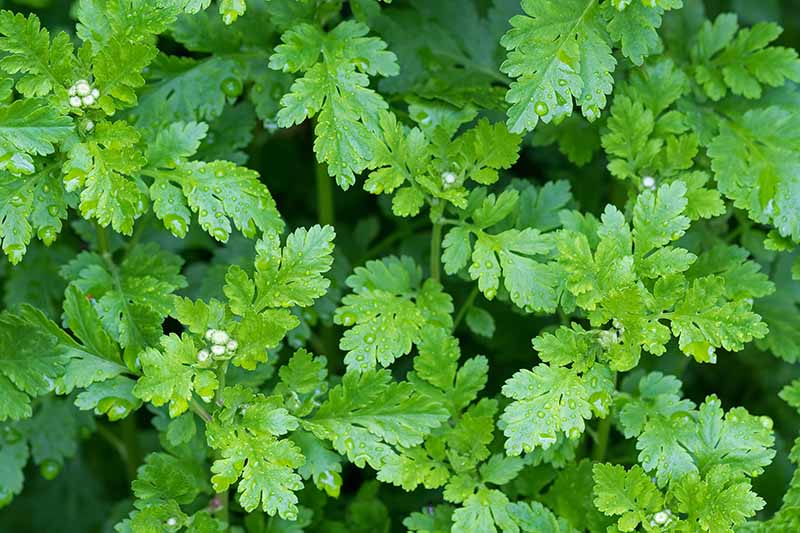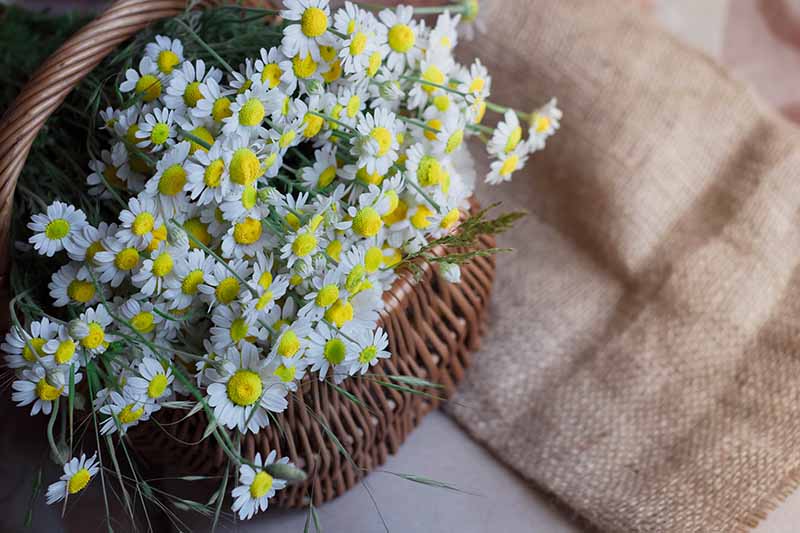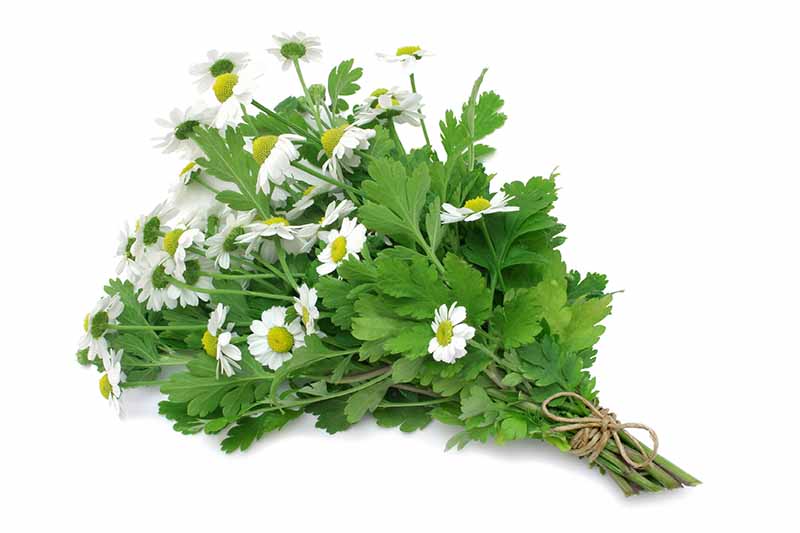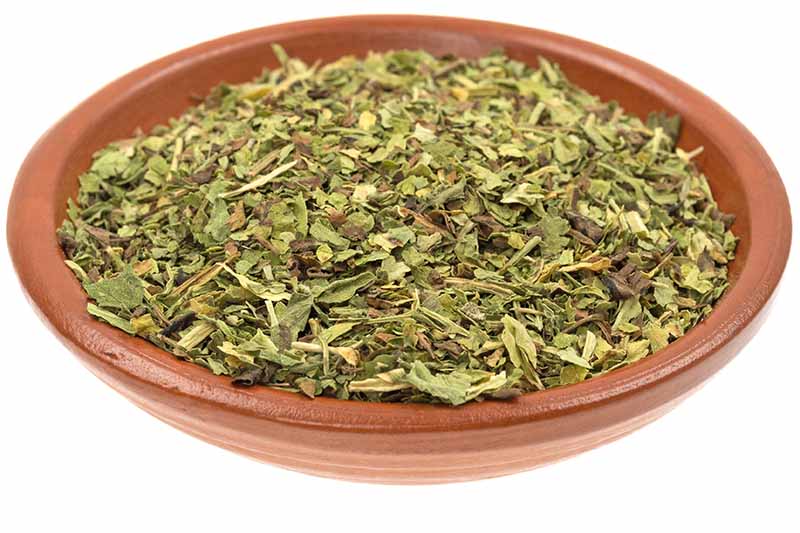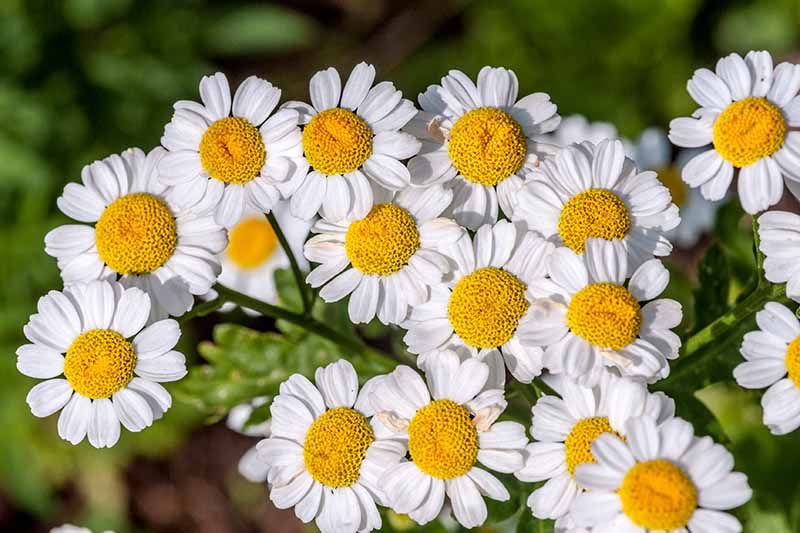An ancient medicinal, this perennial herb has made a resurgence in modern herb gardens for its useful therapeutic properties, particularly as a migraine remedy, as well as for its attractive daisy-like flowers that conveniently repel pests. Read on to learn how to harvest and use feverfew.
What Is Feverfew?
This tender perennial is a member or the aster family, though it is often grown as an annual in cooler climates. It has light green hairy leaves and dense clusters of daisy-like flowers at the tops of its stalks. The lovely little flowers look very similar to chamomile blooms, and the two are often confused.
To learn more about growing feverfew, check out the full guide here.
History
Feverfew has a long history of use in traditional and folk medicine for treatment of many ailments such as headaches, fevers, rheumatoid arthritis, joint pain, toothaches, insect bites, and stomach aches.
Native to southeastern Europe, its use was widespread among early European herbalists. It was named “parthenium” – now part of its botanical name Tanacetum parthenium – by ancient Greeks. The name parthenium is derived from either the Greek word παρθένος (parthenos), meaning “virgin,” or παρθένιον (parthenion), an ancient name for a plant. As legend goes, the herb was used to save the life of someone who had fallen from the Parthenon during its construction in the fifth century BC.
In 1772 John Hill referred to feverfew in his book “The Family Herbal.” He described the plant as “surpassing anything previously used against headaches.” As a result of this, the herb came to be known as the aspirin of the 18th century. Now widely cultivated throughout the world for its beauty as well as its medicinal properties, this beneficial herb is making a comeback!
Medicinal Use
Long used by herbalists and traditional healers as a remedy for migraines, the scientific community has seen a recent increase in research to investigate its effectiveness and use as a treatment or preventative. The main active ingredient is parthenolide, which is found in the leaves but not the stems, though it also contains flavonoids including luteolin, tanetin, santin, and jaceidin. Pregnant women should avoid taking feverfew, as it may cause early contractions. What’s more, research to ensure it’s safe for breastfeeding women is insufficient. People with allergies to ragweed or other related plants from the Asteraceae or Compositae plant families — such as daisies, marigolds, and chrysanthemums — should avoid it. The active ingredient parthenolide can cause contact allergic dermatitis in some people when used on the skin. Consumption of the fresh leaves and flowers may cause canker sores and swelling of the mouth in some individuals. Consult your doctor or healthcare professional before administering any herbal treatments, as herbal supplements may interact with certain medications and are not suitable for everyone.
Several studies have been conducted that point to its effectiveness in reducing migraine frequency or duration – as opposed to an instant cure – in patients who regularly take a supplement containing an extract of the active ingredient.
Health Canada recommends a daily dosage of 125 milligrams of dried leaves containing at least 0.2% parthenolide for the prevention of migraines. But obviously, in our own homes we’re not able to test for the specific levels of active ingredients! According to David Hoffman in his book “Medical Herbalism: The Science Principles and Practices of Herbal Medicine,” with chemical properties that may inhibit eicosanoides, leukocytes, and platelet aggregation, feverfew may be used to prevent blood vessel constriction that can trigger migraines. Medical Herbalism: The Science Principles and Practices of Herbal Medicine This remedy seems to be reliant on a cumulative, building effect in helping to prevent migraines. She goes on to say that best results are achieved in those who eat a few leaves or take capsules daily, over a period of 3-4 weeks. There have also been some studies done looking into the anti-inflammatory properties of this plant, though results are as yet inconclusive. The herb also makes an excellent natural insect repellent. Its strong and bitter scent works wonders to keep unwanted bugs and biting insects such as mosquitoes out of the garden and off your skin!
When to Harvest
Both the leaves and flowers can be harvested and used medicinally. The ideal time to harvest is around the start of flowering – generally in early to mid-summer – though the leaves can be harvested any time throughout the season. The plant has the highest levels of essential oils as it begins to flower, but before it’s in full bloom.
Flowers should be harvested when the plant is in full bloom to maximize yields. The seeds are not edible, but you might like to harvest some to save for planting next year. To do this, wait until the plant has finished flowering, and allow the seed heads to dry. Cut the stems and hang upside down in a paper bag in a cool, dry location for a few days. Shake the bag and separate out the tiny seeds.
How to Harvest
Plan to harvest on a warm, dry day. Wait until mid-morning, after the dew has dried off. Choose healthy foliage, discarding any parts that look damaged or diseased. Cut foliage and flowers cleanly with gardening shears or a sharp knife, leaving the bottom two-thirds of the plant intact.
Be sure to leave some blooms and foliage behind – gather only about a third of the plant at one time, so it can continue growing. A few weeks later, you can harvest again. This plant will continue to produce flowers from July to the end of September.
Preserving and Using Feverfew
This herb can be used fresh or dried. It can be brewed as a tea, taken as a tincture, made into capsules, or used to make homemade insect repellent. To air dry, tie several cut stalks into bundles and hang upside down in a dry, dark place for up to a week.
You can also use a dehydrator or oven set at 140°F. Using a low heat will help to preserve the essential oils – you want the leaves to be dry and crumbly before you store them, but not so dry that they fall apart when you pick them up! Once dried, remove leaves and flowers from the stalks and store in a tightly sealed glass jar in a dark pantry. Find more info on drying and storing herbs in this guide. Use the dried leaves and flowers to make a tea to prevent headaches. The tea can also be cooled and applied to the skin as an insect repellent, or used on pets as a natural flea rinse – provided, of course, that you’re not allergic or sensitive to it. Always test on a small area of your skin before use, and consult with a medical professional if you’re in any doubt that it’s safe for you to use. Add about a quarter of a cup of fresh leaves and blooms – or 2 tablespoons dried – to a cup of boiling water, allow to steep for five minutes, then strain and cool. Flying insects generally hate the pungent smell of the growing plant, so if you’re plagued by mosquitoes try planting in pots on your patio – even the cut flower stems in a vase can deter flies.
Some migraine sufferers choose to eat the leaves as a preventative treatment. I’ve known of instances where gardeners with chronic migraines like to eat a few leaves every day, disguised in a sandwich or salad to mask their bitter flavor. Caution is advised when eating the fresh leaves. Some people can develop canker sores after consuming the fresh leaves or liquid. To avoid this, this herb is often taken in capsule form.
Do you have experience harvesting and using feverfew? Tell us your stories in the comments below! If you’re interested in growing herbs in your garden, you’ll need these guides:
How to Grow Fenugreek When and How to Harvest Caraway Seed Growing and Harvesting Fennel
© Ask the Experts, LLC. ALL RIGHTS RESERVED. See our TOS for more details. Uncredited photos: Shutterstock. With additional writing and editing by Clare Groom and Allison Sidhu. The staff at Gardener’s Path are not medical professionals and this article should not be construed as medical advice intended to assess, diagnose, prescribe, or promise cure. Gardener’s Path and Ask the Experts, LLC assume no liability for the use or misuse of the material presented above. Always consult with a medical professional before changing your diet or using plant-based remedies or supplements for health and wellness.
